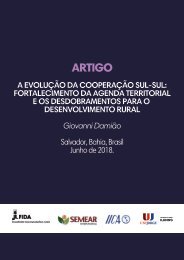The Evolution of South-South Cooperation
Since the Bandung Conference in 1955, the countries of the South have organized themselves in a structured way to achieve better levels of development. This article aims to present the evolution and recent trends of South-South Cooperation, showing how the historical dynamics have led the United Nations and its agencies to adopt a territorial approach, with a strong appeal to mobilize local actors. Allied to this, the increase of the independence of the actors that, with autonomy, manage to dialogue and conduct initiatives of cooperation outside the formal sphere of the central government. This article also aims to present rural development, agriculture and food security as essential factors for the development that since 1978, with BAPA (Buenos Aires Plan of Action), is one of the main thematic lines presented when it comes to the development of the southern agenda. Alongside this, the challenges presented by the prioritization of market dynamics in the face of social development, and how some of the multilateral agencies have worked to promote the facilitation of South-South cooperation and empowerment of minorities, in the achievement of governance as a strategy for endogenous and localized development
Since the Bandung Conference in 1955, the countries of the South have organized themselves in a structured way to achieve better levels of development. This article aims to present the evolution and recent trends of South-South Cooperation, showing how the historical dynamics have led the United Nations and its agencies to adopt a territorial approach, with a strong appeal to mobilize local actors.
Allied to this, the increase of the independence of the actors that, with autonomy, manage to dialogue and conduct initiatives of cooperation outside the formal sphere of the central government. This article also aims to present rural development, agriculture and food security as essential factors for the development that since 1978, with BAPA (Buenos Aires Plan of Action), is one of the main thematic lines presented when it comes to the development of the southern agenda. Alongside this, the challenges presented by the prioritization of market dynamics in the face of social development, and how some of the multilateral agencies have worked to promote the facilitation of South-South cooperation and empowerment of minorities, in the achievement of governance as a strategy for endogenous and localized development
Create successful ePaper yourself
Turn your PDF publications into a flip-book with our unique Google optimized e-Paper software.
Furthermore, it is observed that such programs aim to foster the development <strong>of</strong> local<br />
governance strategies, through the inclusion <strong>of</strong> territorial actors, from different sectors, into the<br />
process <strong>of</strong> building and structuring territoriality. Thus, within the project is created the political<br />
structure composed <strong>of</strong> local governments and civil society in the Territorial Committee, which:<br />
"defines the Territory development plan, determines needs, agrees on the action agenda,<br />
promotes integration <strong>of</strong> efforts, discusses alternatives for development <strong>of</strong> the Territory and exercises<br />
the social control <strong>of</strong> the program" (BRASIL, 2009).<br />
development. Social participation and actions integrated between the Federal<br />
Government, states and municipalities are fundamental for the construction <strong>of</strong> this<br />
strategy. <strong>The</strong> Territory is formed by a set <strong>of</strong> municipalities with the same economic<br />
and environmental characteristic, social, cultural and geographical identity and<br />
cohesion. Larger than municipalities and smaller than states, Territories show, more<br />
clearly, the reality <strong>of</strong> social groups, economic activities, and institutions <strong>of</strong> each<br />
locality. This facilitates the planning <strong>of</strong> governmental actions for development <strong>of</strong><br />
these regions (BRASIL, 2009).<br />
Brazil was not the only country that adopted this type <strong>of</strong> territoriality to foster development.<br />
<strong>The</strong> book Beyond the City: the rural contribution to development (2004) attests the adoption <strong>of</strong> the<br />
territorial approach in Latin America. According to the publication, the spatial approach, name<br />
given by the World Bank to this initiative, is present in the largest economies <strong>of</strong> the region, among<br />
them: Mexico, Brazil, Chile and Colombia (World Bank, p. 119, 2004). And, also, the roster <strong>of</strong><br />
inclusion strategies features some <strong>of</strong> the Rome-based agencies (IFAD, FAO and the World Food<br />
Programme) <strong>of</strong> the United Nations, for example the Plan <strong>of</strong> Sovereignty Food and Nutritional<br />
Security <strong>of</strong> Paraguay, which uses the Participatory Territorial Approach as strategy for promotion<br />
and localization <strong>of</strong> development, coordinating local actors (public and private) in the development<br />
<strong>of</strong> new policies that necessarily involve agriculture. FAO, through what they call Participatory and<br />
Negotiated Territorial Development (PNTD), presents, in general terms, the main intention <strong>of</strong> the new<br />
models for promotion <strong>of</strong> social development, which is the governance idea, with diffusion in the<br />
1990s, but with more accurate and effective forms in the 21st century:<br />
Governance brings into play a complex set <strong>of</strong> actors and institutions, not all<br />
belonging to the sphere <strong>of</strong> government; it translates an interdependence between<br />
the powers and institutions associated with collective action. It also involves actor<br />
networks that are autonomous and based on the principle that it is possible to act<br />
without relying on the power <strong>of</strong> the State. In that regard, the definition <strong>of</strong> the critical<br />
dictionary <strong>of</strong> territory could be mentioned, which synthesizes really well other<br />
13




